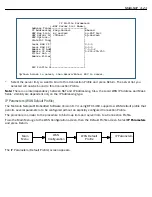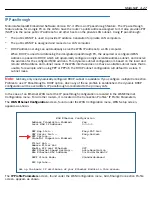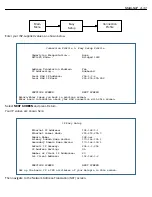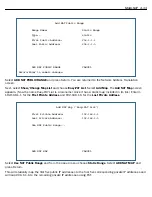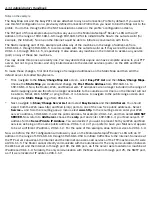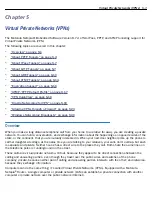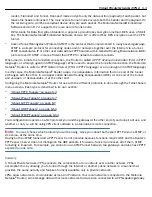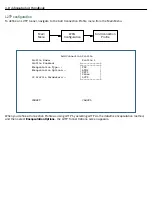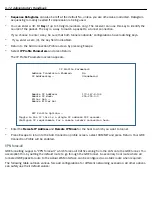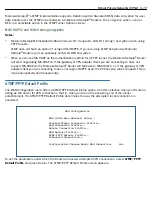
Virtual Private Networks (VPNs) 5-3
modes: Transpor t and Tunnel. Transpor t mode encr ypts only the data por tion (payload) of each packet, but
leaves the header untouched. The more secure Tunnel mode encr ypts both the header and the payload. On
the receiving side, an IPsec-compliant device decr ypts each packet. The Motorola Netopia® Embedded
Software Version 8.7.4 suppor ts the more secure Tunnel mode.
DES
stands for Data Encr yption Standard, a popular symmetric-key encr yption method. DES uses a 56-bit
key. The Motorola Netopia® Embedded Software Version 8.7.4 offers IPsec DES encr yption over the VPN
tunnel.
•
Ascend Tunnel Management Protocol (ATMP) is the protocol that is implemented in many Ascend gateways.
ATMP is a simple protocol for connecting nodes and/or networks together over the Internet via a tunnel.
ATMP encapsulates IP or other user data without PPP headers within General Routing Encapsulation (GRE)
protocol over IP. ATMP is more efficient than PPTP for network-to-network tunnels.
When used to initiate the tunnelled connection, the Router is called a
PPTP Access Concentrator
(
PAC
, in PPTP
language), or a
foreign agent
(in ATMP language). When used to answer the tunnelled connection, the Motorola
Netopia
®
Router is called a
PPTP Network Ser ver
(
PNS
, in PPTP language) or a
home agent
(in ATMP language).
In either case, the Motorola Netopia
®
Router wraps, or encapsulates, information that one end of the tunnel
exchanges with the other, in a wrapper called General Routing Encapsulation (GRE), at one end of the tunnel,
and unwraps, or decapsulates, it at the other end.
Configuring the Motorola Netopia
®
Router for use with the different protocols is done through the Telnet-based
menu screens. Each type is described in its own section:
•
"About PPTP Tunnels" on page 5-4
•
"About IPsec Tunnels" on page 5-7
•
"About L2TP Tunnels" on page 5-7
•
"About GRE Tunnels" on page 5-10
•
"About ATMP Tunnels" on page 5-14
Your configuration depends on which protocol you (and the gateway at the other end of your tunnel) will use, and
whether or not you will be using VPN client software in a standalone remote connection.
Note:
You must choose which protocol you will be using, since you cannot both expor t PPTP and use ATMP, or
vice versa, at the same time.
Having both an ATMP tunnel and a PPTP expor t is not possible because functions require GRE and the Router’s
PPTP expor t/ser ver does not distinguish the GRE packets it for wards. Since it processes all of them, ATMP
tunneling is impaired. For example, you cannot run an ATMP tunnel between two gateways and also have PPTP
expor ted on one side.
Summary
A Vir tual Private Network (VPN) connects the components of one network over another network. VPNs
accomplish this by allowing you to
tunnel
through the Internet or another public network in a manner that
provides the same security and features formerly available only in private networks.
VPNs allow networks to communicate across an IP network. Your local networks (connected to the Motorola
Netopia
®
Router) can exchange data with remote networks that are also connected to a VPN-capable gateway.
Содержание Netopia Embedded Software
Страница 1: ...Administrator s Handbook Motorola Netopia Embedded Seftware Version 8 7 4 Enterprise Series Routers ...
Страница 10: ...x Administrator s Handbook ...
Страница 16: ...1 6 Administrator s Handbook ...
Страница 44: ...2 28 Administrator s Handbook ...
Страница 108: ...3 64 Administrator s Handbook ...
Страница 176: ...5 34 Administrator s Handbook ...
Страница 202: ...6 26 Administrator s Handbook ...
Страница 243: ...IP Setup 7 41 Additional LAN Configuration Name IP Address Additional LAN 1 1 1 1 1 Additional LAN 2 0 0 0 0 ...
Страница 244: ...7 42 Administrator s Handbook ...
Страница 340: ...Index 6 ...

